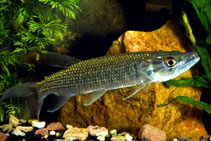| Family: |
Hepsetidae (African pikes) |
| Max. size: |
44.2 cm SL (male/unsexed) |
| Environment: |
demersal; freshwater; pH range: 6 - 7.5; dH range: 18, potamodromous |
| Distribution: |
Africa: easternmost part of West Africa, from the Sassandra River, Ivory Coast, in the west to the Shari River, Central African Republic, in the east; and southwards up to the Kribi River in Cameroon (Ref. 88135). Reports from outside this area refer to other species of Hepsetus (Ref. 88135, 93279, 93907, 108775). |
| Diagnosis: |
Dorsal spines (total): 0-0; Dorsal soft rays (total): 9-9; Anal spines: 0-0; Anal soft rays: 12-12; Vertebrae: 45-49. Diagnosis: This species is distinguished from all other Hepsetus species by the following unique combination of characters: number of lateral line scales low, 43–51; nostril-lower jaw distance short, 36.6–42.1% of head length; number of gill rakers high, 17–23; number of scales between dorsal fin and lateral line 7.5-9.5; number of scales between adipose fin and lateral line 4.5-6.5; head width broad, 32.8–42.3% of head length; and internasal distance high, 21.9–28.3% of head length (Ref. 88135).
Description: Head broad but shallow, with relatively long but broad snout; body elongated and broad, which gives it a plump appearance (Ref. 88135). Dorsal and anal fins, though in a posterior position in all Hepsetus species, more anteriorly positioned relatively to other Hepsetus (Ref. 88135). Small number of lateral line scales, 43-51; 11-18 predorsal scales; 15-20 dorsal-adipose scales; 11-17 adipose-caudal scales; number of scales between dorsal fin and lateral line 7.5-9.5; number of scales between adipose fin and lateral line 4.5-6.5 (Ref. 88135, 94534). Large number of quite small gill rakers on epibranchiale of first gill arch, 17-23 (Ref. 88135).
Colouration: dorsal side of head and body brownish, with a gradual change from darker to lighter tones on flanks; entirely yellowish ventrally; some specimens darker brownish and more uniformly coloured; a vague horizontal line pattern on the flanks, from anterior border of adipose fin, occasionally from posterior border of dorsal fin, to caudal fin base, resulting from the scales having a darker upper and lower border, whereas remaining part of scales remains paler; these lines cover the flanks from approximately three scale rows above lateral line down to two scale rows below the lateral line; sometimes series of 10-16 greyish vertical bands are present on the dorsolateral body parts; the presence of these bands appears to be linked to stress; rounded dorsoventrally elongated blackish spot behind head and just above lateral line (Ref. 88135). Posterior part of head with three, well-marked, dark brownish bands running from posterior border of eye to anterior edge of preopercle; bands sometimes faded and poorly visible; lower half of postopercle brownish, sometimes blackish; rounded dorsoventrally elongated blackish spot behind head, above lateral line (Ref. 88135). All fins but the adipose fin yellowish to dark brownish, more or less the same as body colour; distally translucent; caudal fin translucent, in mid-centre and proximally on upper and lower lobes; dorsal, anal and caudal fins with prominent small, roundish, dark-brown spots; spots on fins more prominent on larger specimens, larger than about 150mm standard length; adipose fin base yellowish to darker brownish, black distally (Ref. 88135). |
| Biology: |
This species seems to prefer upper river courses or small rivers where Hydrocynus species are absent or scarce (Ref. 81278). |
| IUCN Red List Status: |
Least Concern (LC); Date assessed: 15 May 2019 Ref. (130435)
|
| Threat to humans: |
harmless |
Source and more info: www.fishbase.org. For personal, classroom, and other internal use only. Not for publication.

